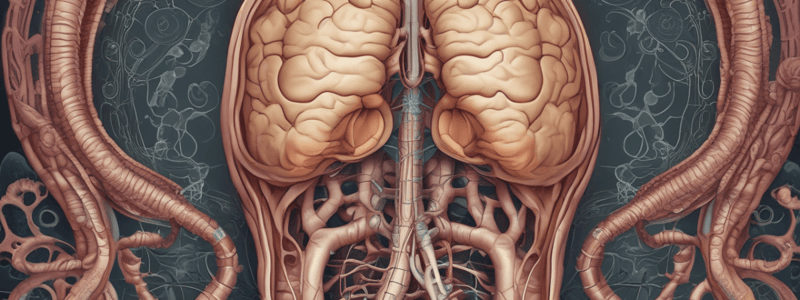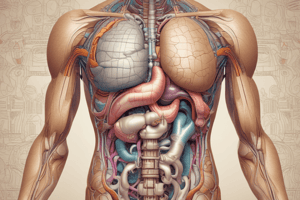Podcast
Questions and Answers
What is the primary function of the stomach?
What is the primary function of the stomach?
- To absorb nutrients into the bloodstream
- To produce hormones and regulate the digestive system
- To store and eliminate waste products
- To break down proteins and fats into smaller molecules (correct)
Which part of the small intestine is responsible for the absorption of most nutrients?
Which part of the small intestine is responsible for the absorption of most nutrients?
- Duodenum
- Cecum
- Jejunum and ileum (correct)
- Rectum
What is the function of microvilli in the small intestine?
What is the function of microvilli in the small intestine?
- To mix food with gastric juices
- To increase the surface area for absorption (correct)
- To produce hormones and regulate the digestive system
- To secrete digestive enzymes
What is the role of the pancreas in the digestive system?
What is the role of the pancreas in the digestive system?
What is the function of the gut microbiome?
What is the function of the gut microbiome?
What is the result of lactase deficiency?
What is the result of lactase deficiency?
What is the role of bile in the digestive system?
What is the role of bile in the digestive system?
How are amino acids and monosaccharides absorbed into the bloodstream?
How are amino acids and monosaccharides absorbed into the bloodstream?
What is the primary site of absorption in the digestive system?
What is the primary site of absorption in the digestive system?
How are short-chain fatty acids absorbed into the bloodstream?
How are short-chain fatty acids absorbed into the bloodstream?
What is the primary function of the sublingual gland?
What is the primary function of the sublingual gland?
What is the role of the pharynx in the digestive system?
What is the role of the pharynx in the digestive system?
What is the function of the esophagus in the digestive system?
What is the function of the esophagus in the digestive system?
What is the purpose of the mucosa lining in the esophagus?
What is the purpose of the mucosa lining in the esophagus?
What is the primary function of the mechanical function in the digestive system?
What is the primary function of the mechanical function in the digestive system?
What is the daily production of saliva by the salivary glands?
What is the daily production of saliva by the salivary glands?
What is the role of amylase in the digestive system?
What is the role of amylase in the digestive system?
What is the name of the muscular tube that propels the bolus towards the stomach?
What is the name of the muscular tube that propels the bolus towards the stomach?
What is the primary function of the parotid gland?
What is the primary function of the parotid gland?
What is the name of the process by which the esophagus propels the bolus towards the stomach?
What is the name of the process by which the esophagus propels the bolus towards the stomach?
What is a potential consequence of decreased saliva production in older adults?
What is a potential consequence of decreased saliva production in older adults?
What is a common digestive problem in older adults due to changes in the stomach?
What is a common digestive problem in older adults due to changes in the stomach?
What can decreased motility in the small intestine lead to?
What can decreased motility in the small intestine lead to?
What is a recommended management strategy for older adults with digestive problems?
What is a recommended management strategy for older adults with digestive problems?
What is a potential consequence of atrophy of the taste buds in older adults?
What is a potential consequence of atrophy of the taste buds in older adults?
What is a common change in the mouth that occurs with aging?
What is a common change in the mouth that occurs with aging?
What is a potential consequence of decreased motility in the esophagus?
What is a potential consequence of decreased motility in the esophagus?
What is a recommended strategy for preventing tooth loss in older adults?
What is a recommended strategy for preventing tooth loss in older adults?
What is a potential consequence of decreased blood flow to the digestive system?
What is a potential consequence of decreased blood flow to the digestive system?
What is a common change in the stomach that occurs with aging?
What is a common change in the stomach that occurs with aging?
Flashcards are hidden until you start studying
Study Notes
Here is a summary of the text in detailed bullet points:
• The digestive system, also known as the digestive apparatus, is a set of organs that work together to transform food into simpler elements that can be absorbed and utilized by the body.
• The digestive process involves four main functions: mechanical or transportation function, chemical or secretion function, absorptive function, and excretory function.
• The mechanical function involves mastication, salivation, and deglutition, which break down food into smaller pieces, mix it with saliva, and form a bolus that can be swallowed.
• Saliva is produced by three main salivary glands: sublingual, submaxillary, and parotid glands, which produce around 1-1.5 liters of saliva per day.
• The parotid gland produces a serous type of saliva, while the submaxillary gland produces a mixed type of saliva, and the sublingual gland produces a mucous type of saliva.
• The salivary glands also produce enzymes such as amylase, which breaks down carbohydrates into simpler sugars.
• The mouth is the first part of the digestive system, where food is chewed and mixed with saliva to form a bolus.
• The bolus then passes through the pharynx, which is a shared pathway for both food and air.
• The esophagus is a muscular tube that uses peristaltic movements to propel the bolus towards the stomach.
• The esophagus is lined with a mucosa that produces mucus to facilitate the passage of food.
• The stomach is a sac-like organ that secretes digestive enzymes and acids to break down proteins and fats.
• The stomach has four main parts: the cardia, fundus, body, and pylorus, each with distinct functions.
• The stomach secretes gastric juices that contain pepsin and hydrochloric acid, which break down proteins into peptides and amino acids.
• The stomach also has a muscular layer that contracts and relaxes to mix food with gastric juices.
• The pylorus is the narrowest part of the stomach, which leads to the small intestine.
• The small intestine is a long, thin tube that absorbs nutrients from food into the bloodstream.
• The small intestine has three main parts: the duodenum, jejunum, and ileum, each with distinct functions.
• The duodenum is the first part of the small intestine, where bile and pancreatic juices are secreted to aid in digestion.
• The jejunum and ileum are the middle and last parts of the small intestine, respectively, where most of the absorption of nutrients takes place.
• The walls of the small intestine are lined with finger-like projections called villi, which increase the surface area for absorption.
• The villi are covered with microvilli, which are small, finger-like projections that increase the surface area even further.
• The small intestine also has enzymes such as lactase, sucrase, and maltase that break down lactose, sucrose, and maltose into simpler sugars.
• The pancreas produces pancreatic juices that contain enzymes such as amylase, lipase, and trypsin that break down carbohydrates, fats, and proteins.
• The bile produced by the liver and stored in the gallbladder is secreted into the small intestine to aid in the digestion of fats.
• The large intestine, also known as the colon, is responsible for absorbing water and electrolytes, and storing and eliminating waste products.
• The large intestine has four main parts: the cecum, colon, rectum, and anus, each with distinct functions.
• The large intestine is home to a diverse community of microorganisms known as the gut microbiome.
• The gut microbiome plays an important role in the digestion and absorption of nutrients, as well as in the immune system and overall health.
• The excretory function of the digestive system involves the elimination of waste products through the anus.
• The digestive system is controlled by a complex system of hormones and nerves that regulate the secretion of digestive enzymes and acids, as well as the movement of food through the digestive tract.• The intestinal brush border has enzymes that act on disaccharides, such as lactase, maltase, and sucrase, which break down lactose, maltose, and sucrose into monosaccharides. • Lactase deficiency can lead to lactose intolerance, characterized by diarrhea, due to the inability to break down lactose into glucose and galactose. • The pancreas secretes amylase, which breaks down carbohydrates into monosaccharides, and lipase, which breaks down triglycerides into fatty acids and glycerol. • Bile from the liver and gallbladder helps organize fatty acids and glycerol, but does not break them down. • The absorption of amino acids and monosaccharides occurs through the microvilli of the intestinal wall, which increases the surface area for absorption. • Amino acids and monosaccharides are transported to the liver via the hepatic portal vein, where they are metabolized, and then enter the general circulation. • Lipids are absorbed with the help of bile salts and lipase, which form an emulsion that allows lipase to break down triglycerides into fatty acids and glycerol. • Fatty acids and glycerol are then absorbed into the lymphatic system, where they form chylomicrons, which are transported to the general circulation via the thoracic duct. • Short-chain fatty acids can also be absorbed directly into the bloodstream through passive diffusion. • The small intestine is the primary site of absorption, but vitamins can also be absorbed in the upper part of the small intestine. • Vitamin B12 is absorbed in the duodenum with the help of intrinsic factor, and iron is absorbed in the duodenum as well. • The large intestine is responsible for absorbing water and ions, and can also ferment undigested carbohydrates, producing gases such as methane and hydrogen sulfide. • The gut microbiota, which makes up 3% of feces, contributes to the fermentation of undigested carbohydrates and provides protection against exogenous bacteria. • The rectum acts as a temporary storage site for feces, awaiting defecation, and is controlled by two sphincters: an involuntary internal sphincter and a voluntary external sphincter.
Studying That Suits You
Use AI to generate personalized quizzes and flashcards to suit your learning preferences.




